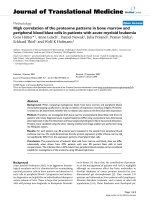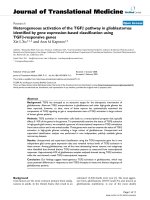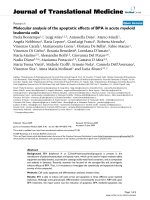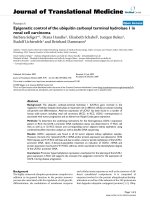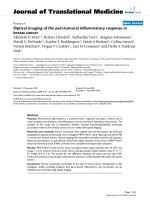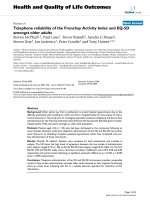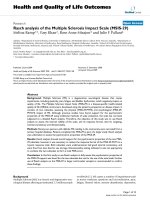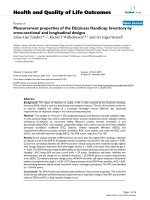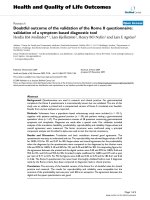báo cáo hóa học:" Arthroscopic debridement of the osteoarthritic knee combined with hyaluronic acid (Orthovisc®) treatment: A case series and review of the literature" docx
Bạn đang xem bản rút gọn của tài liệu. Xem và tải ngay bản đầy đủ của tài liệu tại đây (430.92 KB, 8 trang )
BioMed Central
Page 1 of 8
(page number not for citation purposes)
Journal of Orthopaedic Surgery and
Research
Open Access
Research article
Arthroscopic debridement of the osteoarthritic knee combined
with hyaluronic acid (Orthovisc
®
) treatment: A case series and
review of the literature
Xinning Li*, Agam Shah, Patricia Franklin, Renee Merolli, Jill Bradley and
Brian Busconi
Address: University of Massachusetts Medical Center, Department of Orthopaedic Surgery, Division of Sports Medicine, 55 Lake Avenue North,
Worcester, MA 01655, USA
Email: Xinning Li* - ; Agam Shah - ; Patricia Franklin - ;
Renee Merolli - ; Jill Bradley - ; Brian Busconi -
* Corresponding author
Abstract
Objective: An evaluation of safety and efficacy of high molecular weight hyaluronan (HA)
delivered at the time of arthroscopic debridement of the osteoarthritic knee.
Methods: Thirty consecutive patients who met inclusion and exclusion criteria underwent
arthroscopic debridement by a single surgeon and concomitant delivery of 6 ml/90 mg HA
(Orthovisc
®
). These patients were evaluated preoperatively, at 6 weeks, 3 and 6 months post-
operatively. Evaluations consisted of WOMAC pain score, SF-36 Physical Component Summary
(PCS) score and complications.
Results: No complications occurred during this study. Pre-op average WOMAC pain score was
6.8 +/- 3.5 (n = 30) with a reduction to 3.4 +/- 3.1 at 6 weeks (n = 27). Final average WOMAC pain
score improved to 3.2 +/- 3.8 at six months (n = 23). No patients had deterioration of the
WOMAC pain score. Mean pre-operative SF-36 PCS score was 39.0 +/- 10.4 with SF-36 PCS score
of the bottom 25th percentile at 29.9 (n = 30). Post procedure and HA delivery, mean PCS score
at 6 weeks improved to 43.7 +/- 8.0 with the bottom 25th percentile at 37.5 (n = 27). At 6 months,
mean PCS score was 48.0 +/- 9.8 with the bottom 25th percentile improved to 45.8 (n = 23).
Conclusion: The results show that concomitant delivery of high molecular weight hyaluronan
(Orthovisc
®
– 6 ml/90 mg) is safe when given at the time of arthroscopic debridement of the
osteoarthritic knee. By delivering HA (Orthovisc
®
) at the time of the arthroscopic debridement,
there may be a decreased risk of joint infection and/or injection site pain. Furthermore, the
combination of both procedures show efficacy in reducing WOMAC pain scores and improving SF-
36 PCS scores over a six month period.
Published: 17 September 2008
Journal of Orthopaedic Surgery and Research 2008, 3:43 doi:10.1186/1749-799X-3-43
Received: 9 May 2008
Accepted: 17 September 2008
This article is available from: />© 2008 Li et al; licensee BioMed Central Ltd.
This is an Open Access article distributed under the terms of the Creative Commons Attribution License ( />),
which permits unrestricted use, distribution, and reproduction in any medium, provided the original work is properly cited.
Journal of Orthopaedic Surgery and Research 2008, 3:43 />Page 2 of 8
(page number not for citation purposes)
Introduction
Osteoarthritis (OA) is the most prevalent musculoskeletal
disorder and the leading cause of disability in adults over
the age 45 years [1-3]. OA of the knee is extremely com-
mon, with some studies showing that OA of the knee
occurs in at least 30% of people after the age of 50 years,
and in 80% of people older than 75 years [4,5]. Of the
patients with OA, over 80% will have limitation of move-
ment and greater than 25% can not perform their activi-
ties of daily living [3]. Traditionally, conservative
treatment for knee OA has been symptomatic and
includes basic analgesics, i.e. acetaminophen, non-steroi-
dal anti-inflammatory drugs, intra-articular injection of
glucocorticoids, activity modification, weight loss with
exercise, and physical therapy. Recently, Anakinra, an IL-1
receptor antagonist (IL-1RA) has shown effectiveness in
treating OA in a multi-center randomized clinical trial
[6,7]. Furthermore, insulin as a slow releasing formula-
tion may also have potential benefits in the treatment of
OA [8]. Surgical treatments for patient refractory to con-
servative management include arthroscopic debridement
plus joint lavage or unicompartmental/total joint arthro-
plasty.
Arthroscopy for knee OA has remained a topic of contro-
versy amongst clinicians. Multiple clinical trials discuss
the efficacy of arthroscopic debridement and/or lavage in
the treatment of knee OA [2,9-21]. The procedure serves
to remove the products of cartilage wear, mechanical irri-
tations, inflammatory cells and molecules from the joint;
therefore counter the onset of painful inflammatory
phases of OA. Despite numerous studies, debate over the
role, indications, and long term efficacy of arthroscopic
debridement in the treatment of knee OA still exists
[11,12,15,16,22]. Many investigators have sought for
solutions to improve outcomes after arthroscopic debri-
dement of knee OA, which may involve but not limited to
better patient selection, improved operative technique,
and/or well defined indications [11].
Recently, hyaluronan (HA) injection has contributed as a
treatment modality for knee OA. HA is a type of gly-
cosaminoglycan that naturally exists in the joint space and
contributes to both the viscosity and lubrication in the
normal synovial fluid. It has been studied as a substance
capable of restoring the normal properties of synovial
fluid and cartilage thus reducing pain and stiffness in the
knee of patients with OA [23,24]. Several exogenous prep-
arations of HA exist and are derived from avian or bacte-
rial sources for the expected use of intra-articular
injection. Named viscosupplementation, one proposed
mechanism of action of HA injection is supplementing
the viscous properties of altered pathologic synovial fluid
[24,25]. HA may also have a protective effect on the
chondrocytes and may include additional anti-inflamma-
tory effects: inhibition of phagocytosis [26,27], prostag-
landin synthesis [28], removal of oxygen-free radicals [29]
and suppression of inflammatory cytokine activity [30].
Exogenous injection of HA may also stimulate in vivo syn-
thesis of HA [24]. A recent animal study showed HA was
able to inhibit IL-1beta induced chondrocyte apoptosis in
a dose dependant manner [30].
Standard dosage of HA (Orthovisc
®
) is 2 ml (15 mg of HA/
ml) injection per week for three consecutive weeks, which
may be repeated in 4–6 months with the same protocol
for OA of the knee. Several studies have documented the
efficacy and safety of the use of HA supplementation (2
ml/30 mg/injection) in the OA patient [31-33], however,
there are no studies to date that describe the concomitant
use of 6 ml/90 mg (Orthovisc
®
) HA at the time of the
arthroscopic procedure. The primary goal of our study was
to determine the safety and documenting any complica-
tions after injecting 6 ml/90 mg of Orthovisc
®
(3× the nor-
mal dose) into the knee. Our secondary goal was to
evaluate preliminary efficacy (6 months follow-up) of
combined concomitant HA delivery and arthroscopic
debridement for OA of the knee utilizing health related
questionnaires (WOMAC and SF-36).
Methods and materials
This investigation was approved by and performed in
accordance with the guidelines of the institutional review
board at our hospital. Thirty consecutive patients under-
going knee arthroscopy between the ages of 21–65 years
with knee osteoarthritis who met the inclusion and exclu-
sion criteria were recruited for this study. This patient pop-
ulation consisted of nineteen males and eleven females
with an average age of 46 years. All patients carried a pre-
liminary diagnosis of osteoarthritis (via MRI and plain
radiograph) and were candidates for primary arthroscopic
treatment of a unilateral knee secondary to a meniscal
pathology, loose bodies, or osteochondral defect. Failed
conservative treatment modalities of at least 6 months
included, but were not limited to activity modification,
weight loss, physical therapy, and oral medication.
Patients who were candidates for unicompartmental or
total knee arthroplasty were excluded from this study. All
patients presented with pain greater than or equal to 3/10
as measured by the Visual Analog Scale (VAS). The diag-
nosis of osteoarthritis was further confirmed at the time of
arthroscopy with all included patients having at least a
Grade II or III lesion per the International Cartilage Repair
Society (ICRS) in one of the compartments of the knee.
Any patients found to have rheumatoid arthritis, avascular
necrosis, or any other of the inflammatory arthritis was
excluded from this study. Patients were also excluded
form the study if any of the following criteria was found
to be pre-existing: Allergy to poultry or avian derived
products, previous surgical interventions to the index
Journal of Orthopaedic Surgery and Research 2008, 3:43 />Page 3 of 8
(page number not for citation purposes)
knee, osteochondritis dessicans lesion greater than 7 mm
in depth, Body Mass Index greater than 35, history of ster-
oid injection to the effected knee within the past three
months, history of hyaluronic acid injection within the
past year, or moderate/greater symptomatic contra-lateral
knee involvement.
All patients were enrolled after a complete history and
physical. An MRI and plain radiographs including AP
weight bearing, lateral, and merchant views of the
involved knee were obtained. All of the patients included
in our study had no radiographic evidence of severe
degenerative joint disease as indicated by the presence of
osteophytes, subchondral sclerosis and/or cysts. Further-
more, all of our study patients had normal knee align-
ment, which falls between 3 to 8 degrees of valgus with no
flexion contractures per physical examination. Patients
were asked to complete VAS, Western Ontario and
McMaster Universities Osteoarthritis Index (WOMAC),
and Short Form-36 Physical Component Summary ques-
tionnaires (SF-36 PCS.)
Between May and July of 2006, a single surgeon (BB) per-
formed all thirty knee arthroscopies. Standard medial and
lateral parapatellar portals were established to perform
the procedure. The patellofemoral joint, medial femoral
tibial joint, and lateral femoral tibial joint were systemat-
ically evaluated. All compartments were graded using the
ICRS grading scale: Grade I was assigned to cartilage that
appeared nearly normal and had superficial lesions only,
Grade II was assigned to abnormal appearing cartilage
lesions that extended less than 50% of the depth of the
cartilage, Grade III was assigned to cartilage lesions that
extended greater than 50% of the depth of the cartilage or
evidence of cartilage blistering or lesions down to the cal-
cified layer, and Grade IV was assigned to lesions that
extended to the subchondral bone plate. Chondroplasties
were performed with a shaver if appropriate (Figure 1 and
2). Meniscal pathology was also noted and appropriately
debrided to a stable state. The knee was thoroughly irri-
gated, all loose bodies were removed, and the knee joint
was appropriately drained. Using the arthroscope for
direct visualization (Figure 3), 6 ml/90 mg of high molec-
ular weight hyaluronic acid (Orthovisc
®
, sodium hyaluro-
nate; Anika Therapeutics, Inc, Woburn, MA) was delivered
into the intra-articular space via an 18 gauge needle under
direct visualization after the arthroscopic procedure (Fig-
ure 4). All portals were subsequently closed with inter-
rupted nylon sutures before the injection of HA with the
exception of the arthroscope portal. Standard dosage of
HA (Orthovisc
®
) is 2 ml/30 mg (15 mg of HA/ml) per
injection per week for three consecutive weeks. Thus
injecting 6 ml/90 mg of HA (Orthovisc
®
) was three times
the normal dosage. After injection, the arthroscope portal
was closed with nylon sutures and sterile dressings were
applied.
Post-operatively, patients were allowed to weight bear as
tolerated with the use of crutches if necessary and were
given a two week prescription for narcotic analgesics
(Vicodin 5/500 mg) for pain control. Patients were asked
to ingest one enteric coated aspirin per day for two weeks
for DVT prophylaxis. The subjects were scheduled to have
appointments at one week, six weeks, three months and
Arthroscopic view of the medial femoral tibia jointFigure 1
Arthroscopic view of the medial femoral tibia joint. A
grade I (ICRS) lesion was noted on the medial femoral con-
dyle and a grade III lesion with cartilage flap was seen on the
medial tibia.
Post arthroscopic debridement of the chondral lesions on the medial femoral condyle and the medial tibiaFigure 2
Post arthroscopic debridement of the chondral
lesions on the medial femoral condyle and the medial
tibia.
Journal of Orthopaedic Surgery and Research 2008, 3:43 />Page 4 of 8
(page number not for citation purposes)
six months post operatively. Any complications were doc-
umented at each visit. A physical therapy (PT) directed
rehab protocol was implemented at one week as per the
surgeon's standard of care. Each patient received three
treatment of PT per week with no restrictions. All patients
were asked to complete SF-36 PCS and WOMAC ques-
tionnaires at the pre op, six week, three month, and six
month visits.
Results
All thirty arthroscopy procedures were performed without
any intra-operative complication. No complications were
documented within the six-month study period to
include, but not limited to infection, bleeding, nerve dam-
age, deep venous thrombosis, pulmonary embolus, aller-
gic reaction, and HA delivery site pain.
ICRS grading showed that the patellofemoral joint had
the greatest amount of involvement with an average grade
of 3.1 +/- 0.5. The medial compartment revealed an aver-
age ICRS grade of 2.8 +/- 0.8 and the lateral compartment
revealed an average grade of 1.8 +/- 0.8. Twenty-six
patients had meniscal tears that required debridement. All
knees had chondroplasty of at least one compartment,
which was performed with a shaver. Two of the thirty
knees were found to have loose bodies greater than five
millimeters in diameter.
Of the thirty patients receiving the index procedure, three
were lost to follow-up at six weeks (n = 27) and an addi-
tional four patients were lost to follow-up at six months
(n = 23). Thus, data was collected for twenty-seven
patients at the six week and three month post-op visit and
for twenty-three patients at the six month visit (77% at
final follow up appointment).
The average pre-operative WOMAC pain score within the
study group was 6.8 +/- 3.5 (n = 30). At the six-week post-
operative visit, the average WOMAC pain score improved
to 3.4 +/- 3.1 (n = 27). At the final six-month visit (n =
23), the average WOMAC pain score improved to 3.2 +/-
3.8 (Figure 5). Ninety-six percent (26/27) of patients had
improvement in WOMAC pain scoring and one patient
had no improvement at the 3 month follow up time. No
patients had deterioration of post-operative WOMAC
pain scores at the 6 months follow up appointment. The
patients were further stratified into those having improve-
ment greater than 15% with outcomes showing 87% of
patients with sustained improvements at the final follow
up (6 months).
The average pre-operative SF-36 Physical Component
Summary (PCS) score within the study group was 39.0 +/
- 10.4 (n = 30). At the six-week post-operative visit, the
average SF-36 PCS score improved to 43.7 +/- 8.0 (n = 27).
At the final six-month visit, the average SF-36 PCS score
improved to 48.0 +/- 9.8 (n = 23). The data was also strat-
ified to calculate changes in the bottom 25
th
percent of
patients. The average pre-operative SF-36 PCS score
within the lowest quartile was 29.9. At the six-week post-
operative visit, the average SF-36 PCS score of the lowest
quartile improved to 37.5. At the final six-month visit, the
average SF-36 PCS score of the lowest quartile improved
to 45.8 (Figure 6). Eighty-seven percent (20/23) of
An 18 gauge needle is inserted into the patellofemo-ral joint under direct arthroscopic visualizationFigure 3
An 18 gauge needle is inserted into the patellofemo-
ral joint under direct arthroscopic visualization.
Hyaluronic Acid (6 ml/90 mg of Orthovisc
®
) is
injected into the knee joint via an 18 gauge needle
and under direct arthroscopic visualization
Figure 4
Hyaluronic Acid (6 ml/90 mg of Orthovisc
®
) is
injected into the knee joint via an 18 gauge needle
and under direct arthroscopic visualization.
Journal of Orthopaedic Surgery and Research 2008, 3:43 />Page 5 of 8
(page number not for citation purposes)
Mean WOMAC Pain Score of all patients at pre op, 6 weeks, 3 months, and 6 monthsFigure 5
Mean WOMAC Pain Score of all patients at pre op, 6 weeks, 3 months, and 6 months.
WOMAC Pain Component
0.00
2.00
4.00
6.00
8.00
10.00
12.00
Pre Op 6 Weeks 3 Months 6 Months
Tim e of Follow Up
Total Pain Scoe
Mean
Mean SF-36 Physical Component Summary (PCS) Score at pre op, 6 weeks, 3 months, and 6 monthsFigure 6
Mean SF-36 Physical Component Summary (PCS) Score at pre op, 6 weeks, 3 months, and 6 months. The red
bar represents the mean scores of all patients in our study and the yellow bar represents the bottom 25th percentile of
patients.
SF-36 Physical Component Score
0
10
20
30
40
50
60
70
Pre Op 6 Weeks 3 Months 6 Months
Time of Follow Up
Physical Function Score
25th Percentile
Mean
Journal of Orthopaedic Surgery and Research 2008, 3:43 />Page 6 of 8
(page number not for citation purposes)
patients had improvement in the SF-36 PCS scores with
three patients having had some deterioration of SF-36
PCS scores at the 6 month time point.
Discussion
Traditional and labeled use of Hyaluronic Acid (HA)
Orthovisc
®
for treatment of pain due to OA of the knee
involves a series of 2 ml (30 mg of HA: 15 mg/ml) injec-
tions weekly in the clinic over a span of three weeks. Some
studies have documented the complication rate of this
injection to be as high as 27% [34], with the most compli-
cation being injection site pain. Other complications of
significance are transient local reactions in the injected
joint, which are typically benign, short lived, without
sequelae, and similar to those observed with any intra-
articular treatment [35]. These adverse reactions have
been found to occur at a rate of 2–4% [31].
In this study using 6 ml/90 mg of Orthovisc
®
, no compli-
cations were noted at the 6 months follow up time period.
The presence of minimal joint swelling was observed in
several patients at the earlier follow up appointments
which can be attributed to the arthroscopic procedure;
however, none of these patients were symptomatic and all
resolved by the 6 months appointment. No patients had
evidence of infection, transient reactions, deep venous
thrombosis, or other neurovascular insult. Delivery site
pain and reaction may have occurred but could remain
disguised by post surgical pain or narcotic use (Vicodin).
Because of these influences, the ability of our study to
detect delivery site pain or other related symptoms were
somewhat limited. Overall, we found that 6 ml/90 mg of
Orthovisc
®
can be given safely at the time of arthroscopy
without any adverse complications. However, this state-
ment can not be generalized to all HA supplements as
Orthovisc
®
was the only HA used in our study. Ulucay et
al. showed no difference in the complications between
three different HA formulations (Orthovisc, Adant, and
Synvisc) after arthroscopic knee debridement for OA [36].
The dosing effect of giving 6 ml/90 mg of Orthovisc
®
when
compared to three separate injections raises concern. Sev-
eral meta-analysis on investigating the safety and efficacy
of HA injections show that the standard dosing is safe and
effective [25,31,32]. Our pilot study results showed at
least equivalent efficacy and safety at the six-month mark.
We did not observe any adverse events at the 6 months
time period with the increased dosage of 6 ml/90 mg of
Orthovisc
®
. Bellamy et al. [37] in a meta-analysis found
that WOMAC pain scores peaked between 5 and 13 weeks
and tended to deteriorate towards baseline over 52 weeks.
Brandt et al. [32] in a randomized control trial of 226
patients found that HA injections improved WOMAC
pain scores for the duration of the study of 30 weeks. Neu-
stadt et al. [33] in a randomized control trial of 272
patients followed over a period of 28 weeks showed that
a WOMAC pain scores improved by greater than 40% in
patients receiving HA when compared to those receiving
placebo. Our study showed consistently improved
WOMAC pain scores after 24 weeks with a single delivery
of 6 ml/90 mg of Orthovisc
®
at the time of the arthro-
scopic debridement with over 79% of our patients having
an improvement of greater than 40%. However the final
follow up in our study was at the six month mark, so we
can not conclude that the improvement in WOMAC pain
score would be sustained for greater than one year.
Dervin et al. [2] performed a study examining the out-
comes of arthroscopic debridement alone on arthritic
knees. They found 44% of the patients in the study sus-
tained a significant decrease in WOMAC pain scores over
two years, where improvement was considered greater
than 15%. Their study population composed of 126
patients with knee OA that is refractory to conservative
management and with significant medial compartment
disease (57% had ICRS Grade III or IV lesions) and menis-
cal tear (63%) which is similar to the patient population
of our study. Compared to this historical control, our
study showed that WOMAC pain scores from the com-
bined procedure was significantly improved in 87% of
our patients and SF-36 PCS scores improved in 89% of
patients at the 6 months follow up. Furthermore, the
patients in the bottom 25th percentile of the SF-36 PCS in
our study improved from 29.9 (pre-op) to 45.8 at the 6
months follow up. However, the length of follow up (6
months) may have skewed our results.
In another study by Mathies et al. [38] HA injection was
performed after arthroscopy for meniscal tears. He found
that patients had less pain at rest and during exercise when
compared to a control group. Patients in the HA group
were also noted to have less joint swelling and better
Lysholm scores. Hempfling el al. [39] in a recent study
compared arthroscopic knee debridement and lavage for
knee OA versus the same procedure with immediate injec-
tion of 10 ml of HA post arthroscopy. A total of 80
patients were followed prospectively for two years with 40
patients in each group. At the one year follow up time
frame, patients in the debridement/lavage and HA group
were found to have statistically longer lasting improve-
ment in walking pain, night pain, and ability to walk 100
meters with no complications observed. It was concluded
that the post-arthroscopic instillation of a HA-based syn-
ovial fluid substitute into the joint is a suitable way of
achieving long-term stabilization of the treatment out-
come. However, their study did not utilize WOMAC and
SF-36 questionnaires to evaluate functional efficacy.
Although differences in the patient population and indi-
cation for arthroscopy exist when compared to our study,
Journal of Orthopaedic Surgery and Research 2008, 3:43 />Page 7 of 8
(page number not for citation purposes)
these above published results correlate with our hypothe-
sis that HA delivered at the time of arthroscopy for oste-
oarthritis of the knee can be performed safely with the
preliminary data showing that the combined procedure is
efficacious in improving patient's pain level and func-
tional outcome.
Another key factor in determining success of the arthros-
copy procedure for knee OA is patient selection. In a
recent review of evidence based factors influencing
arthroscopy for knee OA by Darling et al [40], the authors
recommended arthroscopy for OA only in patients with
short duration of symptoms, medial sided knee pain with
localized tenderness, preservation of the joint space on
radiograph, and mechanical symptoms. Patients with
mechanical mal-alignment, flexion contracture, and obes-
ity are not likely to have long term improvement after
arthroscopy for knee OA. The above statements were also
supported by several other studies [2,11,41]. The results
from our study and other literature reports support the
notion that the addition of HA injection at the time of the
arthroscopy procedure for knee OA will result in better
pain relief with sustained benefits in the right patient pop-
ulation.
There are several limitations in our study. One being that
it is a case series, level IV evidence study with small sample
size of twenty-three patients at the final follow up (6
months). Another significant limitation is that there were
no control group and our data was compared to the his-
torical controls found in literature with a short follow-up
time of six months. This presents bias in terms of patient
population heterogeneity and patient selection across the
different studies. Also majority of our patients had meni-
sectomy in addition to the chondroplasty which could
result in the improved outcome scores. However, the
strength of this study is that all the procedures were per-
formed by a single surgeon (BB) and the results were col-
lected prospectively. To our knowledge, this is also the
first case series study evaluating the preliminary efficacy
and safety of combined HA (Orthovisc
®
) injection at the
time of arthroscopic debridement for OA of the knee uti-
lizing the WOMAC and SF-36 questionnaires. Complica-
tions were also documented for this study group and it
was shown that injection of 6 ml/90 mg of Orthovisc
®
was
safe at the 6 months follow up.
Conclusion
These preliminary data suggest benefits as measured by
the WOMAC and SF-36 from arthroscopic debridement
plus concomitant HA (Orthovisc
®
) delivery in the treat-
ment of knee OA for this patient group. HA injection of 6
ml/90 mg (Orthovisc
®
) was also found to be safe and
without complications at the 6 months follow up time.
However, the relative contributions of arthroscopic debri-
dement versus intra-op HA injection for the treatment of
knee OA should be evaluated in a future randomized, pla-
cebo controlled, double blinded trial.
Competing interests
Funding and HA (Orthovisc
®
) was provided by DePuy-
Mitek.
Authors' contributions
XL, AS, PF, and BB have contributed to the conception/
design, data collection/interpretation, and drafting/revis-
ing of the manuscript. RM and JB contributed to the col-
lection and analyzing of the data. BB performed the
surgical procedures. All authors approved the final manu-
script.
Acknowledgements
The authors wish to thank Dana Deyette and Brad Bisson for their support
and contributions to this study.
References
1. Neustadt DH: Current approach to therapy for osteoarthritis
of the knee. Louisville Med 2004, 51:341-3.
2. Dervin GF, Stiell IG, Rody K, Grabowski J: Effect of arthroscopic
debridement for osteoarthritis of the knee on health-related
quality of life. J Bone Joint Surg Am 2003, 85:10-9.
3. Woolf AD, Pfleger B: Burden of major musculoskeletal condi-
tions. Bull World Health Organ 2003, 81:646-656.
4. Lawrence RC, Helmick CG, Arnett FC, Deyo RA, Felson DT, Giannini
EH, Heyse SP, Hirsch R, Hochberg MC, Hunder GG, Liang MH, Pille-
mer SR, Steen VD, Wolfe F: Estimates of the prevalence of
arthritis and selected musculoskeletal disorder in the United
States. Arthritis Rheum 1998, 41:778-99.
5. Felts W, Yelin E: The economic impact of the rheumatic dis-
eases in the United States. J Rheumatol 1989, 16:867-884.
6. Chevalier X, Giraudeau B, Conrozier T, Marliere J, Kiefer P, Goupille
P: Safety study of intraarticular injection of interleukin 1
receptor antagonist in patients with painful knee osteoar-
thritis: a multicenter study. J Rheumatol 2005, 32(7):1317-1323.
7. Iqbal I, Fleischmann R: Treatment of Osteoarthritis with Anak-
inra. Current Rheumatology Reports 2007, 9:31-35.
8. Cai L, Okumu FW, Cleland JL, Beresini M, Hogue D, Lin Z, Filvaroff
H: A slow release formulation of insulin as a treatment for
osteoarthritis. Osteoarthritis and Cartilage 2002, 10:692-706.
9. Aaron RK, Skolnick AH, Reinert SE, Ciombor DM: Arthroscopic
debridement for osteoarthritis of the knee. J Bone Joint Surg Am
2006, 88:936-943.
10. Jackson RW, Dieterichs C: The results of arthroscopic lavage
and debridement of osteoarthritic knees based on the sever-
ity of degeneration: a 4- to 6-year symptomatic follow-up.
Arthroscopy 2003, 19:13-20.
11. Harwin SF: Arthroscopic debridement for osteoarthritis of
the knee: predictors of patient satisfaction. Arthroscopy 1999,
15:142-146.
12. Bohnsack M, Lipka W, Ruhmann O, Peters G, Schmolke S, Wirth CJ:
The value of knee arthroscopy in patients with severe radio-
logical osteoarthritis. Arch Orthop Trauma Surg 2002,
122:451-453.
13. Shannon FJ, Devitt AT, Poynton AR, Fitzpatrick P, Walsh MG: Short-
term benefit of arthroscopic washout in degenerative arthri-
tis of the knee. Int Orthop 2001, 25:242-245.
14. Timoney JM, Kneisl JS, Barrack RL, Alexander H: Arthroscopy in
the osteoarthritic knee: long term follow-up. Orthop Rev 1990,
19:371-379.
15. Moseley JB, O'Malley K, Peterson N, Menke TJ, Brody BA, Kuykendall
DH, Hollingsworth JC, Ashton CM, Wray NP: A controlled trial of
arthroscopic surgery for osteoarthritis of the knee. The New
England Journal of Medicine 2002, 347:81-88.
Publish with Bio Med Central and every
scientist can read your work free of charge
"BioMed Central will be the most significant development for
disseminating the results of biomedical research in our lifetime."
Sir Paul Nurse, Cancer Research UK
Your research papers will be:
available free of charge to the entire biomedical community
peer reviewed and published immediately upon acceptance
cited in PubMed and archived on PubMed Central
yours — you keep the copyright
Submit your manuscript here:
/>BioMedcentral
Journal of Orthopaedic Surgery and Research 2008, 3:43 />Page 8 of 8
(page number not for citation purposes)
16. Hunt SA, Jazrawi LM, Sherman OH: Arthroscopic management
of osteoarthritis of the knee. J Am Acad Orthop Surg 2002,
10(5):356-363.
17. Aaron RK, Skolnick AH, Reinert SE, Ciombor DM: Arthroscopic
debridement for osteoarthritis of the knee. J Bone Joint Surg Am
2006, 88:936-943.
18. Forster MC, Straw R: A prospective randomized trial compar-
ing intra-articular Hyalgan injection and arthroscopic wash-
out for knee osteoarthritis. Knee 2003, 10:291-293.
19. Jackson RW, Dieterich C: The results of arthroscopic lavage
and debridement of osteoarthritic knees based on the sever-
ity of degeneration: a 4 to 6 year symptomatic follow-up.
Arthroscopy 2003, 19:13-20.
20. Smith MD, Wetherall M, Darby T, Esterman A, Slavotinek J, Robert-
Thomson P, Coleman M, Ahern MJ: A randomized placebo-con-
trolled trial of arthroscopic lavage versus lavage plus intra-
articular corticosteroids in the management of sympto-
matic osteoarthritis of the knee. Rheumatology (Oxyford) 2003,
42:1477-1485.
21. Ravaud P, Moulinier L, Giraudeau B, Ayral X, Guerin C, Noel E, Tho-
mas P, Fautrel B, Mazieres B, Dougados M: Effects of joint lavage
and steroid injection in patients with osteoarthritis of the
knee: results of a multicenter, randomized, controlled trail.
Arthritis Rheum 1999, 42:475-482.
22. Siparsky P, Ryzewicz M, Peterson B, Bartz R: Arthroscopic treat-
ment of osteoarthritis of the knee: are there any evidence-
based indications? Clinical Orthopedics and Related Research 2007,
455:107-112.
23. Kirwan JR, Rankin E: Intra-articular therapy in osteoarthritis.
Baillieres Clin Rheumatol 1997, 11:769-94.
24. Balazs EA, Denlinger JL: Viscosupplementation: a new concept
in the treatment of osteoarthritis. J Rheumatol Suppl 1993,
20(39):3-9.
25. Divine JG, Zazulak BT, Hewett TE: Viscosupplementation for
knee osteoarthritis: a systematic review. Clin Orthop Relat Res
2007, 455:113-22.
26. Forrester JV, Balazs EA: Inhibition of phagocytosis by high
molecular weight hyaluronate.
Immunology 1980, 40:435-46.
27. Pisko E, Turner RA, Soderstrom LP, Panetti M: Inhibition of neu-
trophil phagocytosis and enzyme release by hyaluronic acid.
Clin Exp Rheumatol 1983, 1:41-4.
28. Punzi L, Schiavon F, Cavasin F, Ramonda R, Aambari PF, Todesco S:
The influence of intra-articular hyaluronic acid on PGE2 and
cAMP of synovial fluid. Clin Exp Rheumatol 1989, 7:247-50.
29. Sato H, Takahashi T, Ide H, Fukushima T, Tabata M, Sekine F, Koba-
yashi K, Negishi M, Niwa Y: Antioxidant activity of synnovial
fluid, hyaluronic acid and two subcomponents of hyaluronic
acid. Arthritis Rheum 1988, 31:63-71.
30. Zhou PH, Liu SQ, Peng H: The effect of hyluronic acid on IL-
1beta-induced chondrocyte apoptosis in a rat model of oste-
oarthritis. J Orthop Res 2008.
31. Neustadt D, Caldwell J, Bell M, Wade J, Gimbel J: Clinical effects of
intraarticular injection of high molecular weight hyaluronan
(Orthovisc) in osteoarthritis of the knee: a randomized, con-
trolled, multicenter trial. J Rheumatol 2005, 32(10):1928-36.
32. Brandt KD, Block JA, Michalski JP, Moreland LW, Caldwell JR, Lavin
PT, the Orthovisc Study Group: Efficacy and safety of intraartic-
ular high molecular weight hyaluronan in knee osteoarthri-
tis. Clin Orthop Rel Res 2001, 385:130-43.
33. Petrella RJ, Petrella M: A prospective, randomized, double-
blind, placebo controlled study to evaluate the efficacy of
intraarticular hyaluronic acid for osteoarthritis of the knee.
J Rheumatol 2006, 33(5):951-6.
34. Puttick MPE, Wade JP, Chalmers A, Connell DG, Rangno KK: Acute
local reactions after intraarticular hylan for osteoarthritis of
the knee. J Rheumatol 1995, 22(7):1311-4.
35. Adams ME, Lussier AJ, Peyron JG: A Risk-Benefit Assessment of
Injections of Hyaluronan and its Derivatives in the Treat-
ment of Osteoarthritis of the Knee. Drug Safety 2000,
23(2):115-130.
36. Ulucay C, Altintas F, Ugutmen E, Beksac B: The use of arthro-
scopic defbridement and viscosupplementation in knee oste-
oarthritis. Acta Orthop Traumatol Turc 2007, 41(5):337-342.
37. Bellamy N, Campbell J, Robinson V, Gee T, Bourne R, Wells G: Vis-
cosupplementation for the treatment of osteoarthritis of the
knee. Cochrane Database Syst Rev 2005, 2:CD005321.
38. Mathies B: Effects of Viscoseal, a synovial fluid substitute, on
recovery after arthroscopic partial meniscectomy and joint
lavage. Knee Surg Sports Traumatol Arthrosc 2006, 14(1):32-39.
39. Hempfling H: Intra-articular hyaluronic acid after knee
arthroscopy: a two year study. Knee Surg Sports Traumatol
Arthrosc 2007, 15(5):537-546.
40. Darling J, Nutton RW: Evidence based factors influencing out-
come of arthroscopy in osteoarthritis of the knee. Knee 2008,
15(3):159-163.
41. Day B: The indications for arthroscopic debridement for
osteoarthritis of the knee. Orthop Clin North Am 2005,
36(4):413-417.
